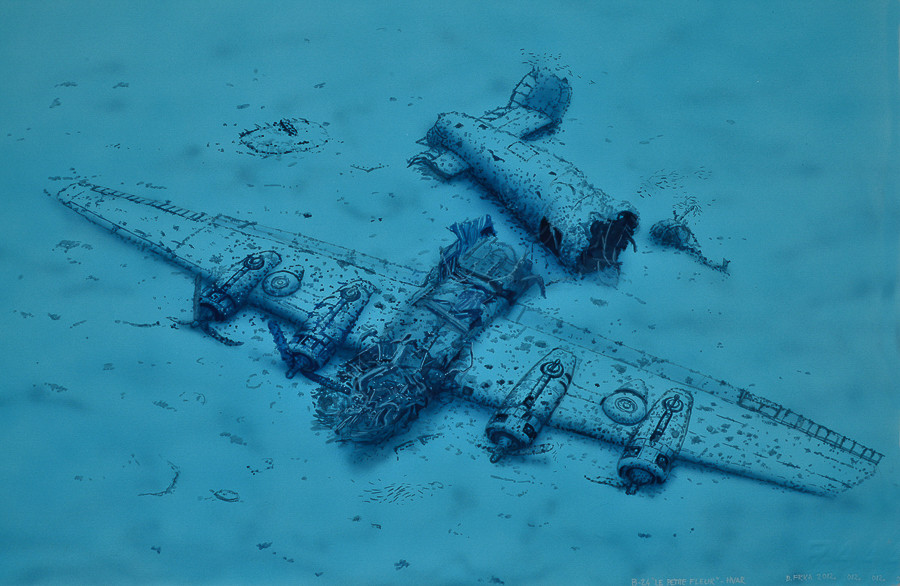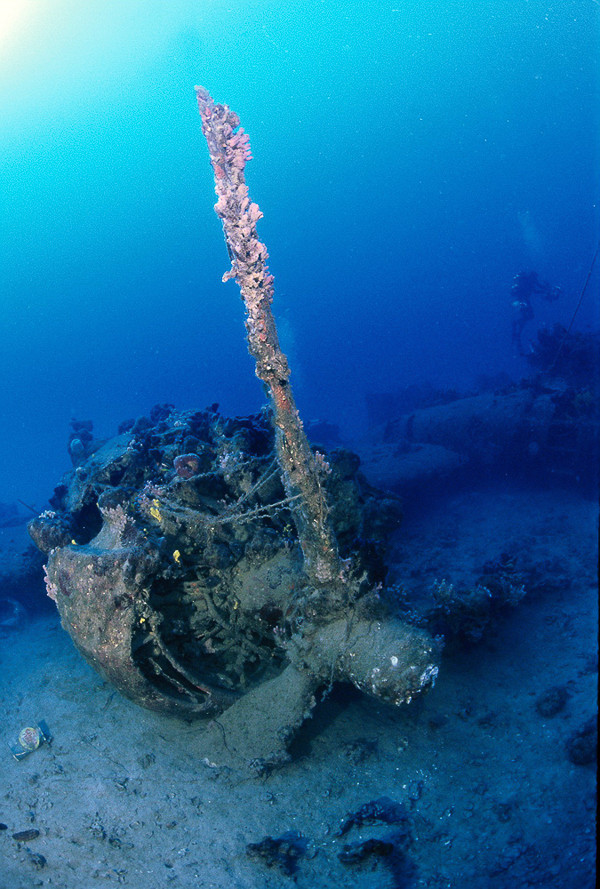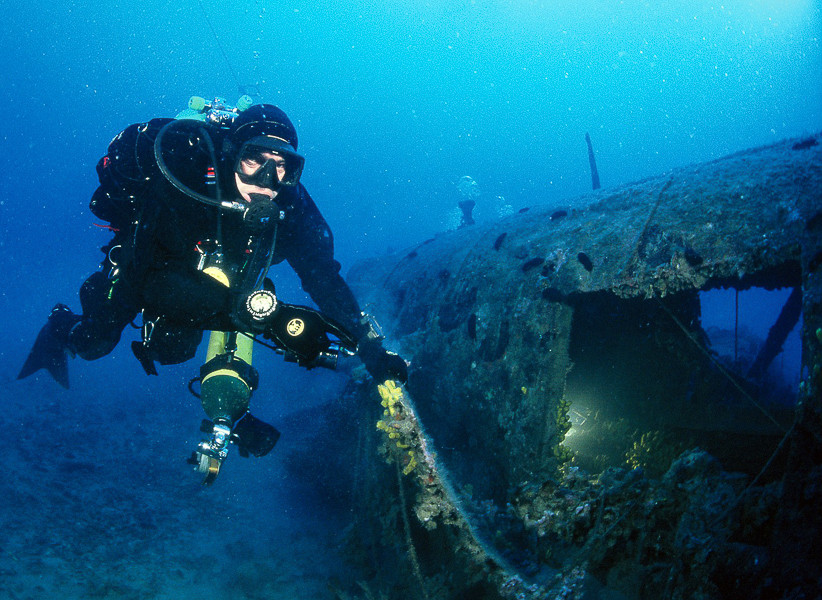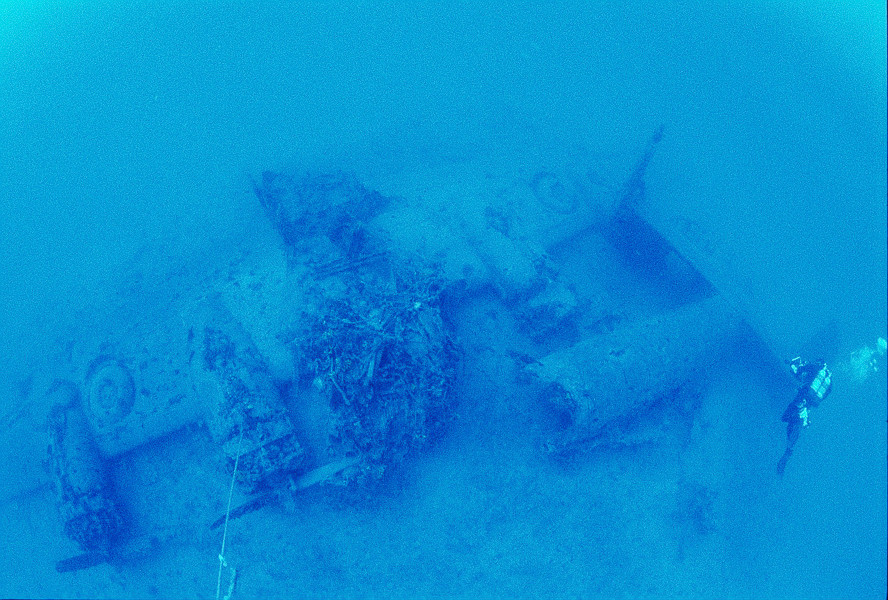
B-24 LIBERATOR - LE PETITE FLEUR
DEPTH: 41 - 45 m
SKILL: Advanced
Consolidated B-24 J-15FO “Le Petite Fleur”; heavy bomber; American, 727th BS, 451st BG, 15th AF
Crashed: 20th November 1944, mission #154 Blechhammer, Germany (cause: anti-aircraft defence)
Dimensions: length=20.472 m, wingspan=33.528 m, weight=25,401 kg (maximum takeoff weight)
Coordinates: 43.11230° N, 17.12287° E
Location: West of Sućurj on the island of Hvar
Access: 1/5 access is solely by boat (the location is in the open sea)
Visibility: 4/5 occasionally very good visibility
Current: 4/5 mostly weak
Flora and fauna: 5/5 varied life on and around the wreck, on the wreck large specimens of fish
HISTORY:
The main bases for US bombers during the years 1944 and 1945 were in Great Britain and southern Italy, from where they could reach out to almost all their targets in Germany. The American 15th Air Force operated from southern Italy from November 1943 until the end of the war. 21 groups of heavy bombers were based in Italy (in each group were three squadrons) of which 15 were armed with B-24 Liberator aircraft, while the other 6 groups were armed with B-17 bomber type Flying Fortresses.
The discovery of the history of the Liberator is credited to the scuba divers who first read its serial number: 251874. Documentation helped me to track down its full identification: B-24 J–15 FO, produced in 1942 at the Ford Factory, Willow Run.
Our Liberator arrived in Italy on 7th September 1944, where it was deployed to the 727th squadron 451st bomber group, with its base at the Castelluccia airfield. The Liberator took part in many actions, from which it always luckily returned along with its crew. Its luck changed just two months later on 20th November 1944, while on mission number 154, when the US Air Force was bombing Blechhammer in Germany. On the return one of the engines of Doherty’s Liberator was damaged, it fell out from the formation, lost altitude, and its fuel was also running low. Due to this while high above the Croatian Adriatic coast, the pilot gave orders to abandon the aircraft. In the chaos which ensued, while the other members of the crew were jumping from the open bomb-bay doors, mechanic-gunner Raymond Hughey accidentally opened his parachute inside the plane. The cords of his parachute became tangled in a complicated knot and Hughey was no longer able to jump out.
Seeing what was happening, pilot Doherty didn’t hesitate – not wanting to leave a helpless member of the crew, he decided to land the heavily damaged bomber on the surface of the sea. The first impact with the sea’s surface was terrible, which was followed by several smaller accompanied by the shattering of metal. Through the open bomb-bay doors water violently hit the rear of the plane, which then almost splintered away from the front part of the fuselage. With a broken back and upside-down, the aircraft was sinking fast (the Liberator was known for its bad sea landing abilities and that its fuselage broke easily). The two aviators quickly escaped through the side windows of the cockpit to immediately find themselves in the ice cold sea. Luckily, the coast was not far so they finally managed to reach dry land on the island of Hvar. Soon after they came across Partisans who kept them warm, and by the evening they met with the rest of the crew which the Partisans had rescued from around the island. The following day, through their well-established connections, the Partisans transferred them to the island of Vis, from where they sailed by steamship to Bari, and then transferred to their base in Castelluccia.
WRECK CONDITION AND DIVING:
The wreck lies at a depth of 42-44 metres and is situated west of Sućuraj on the island of Hvar. Visibility is usually excellent, however after the thirty metre mark it sometimes decreases because of the greenish layer in which small particles are present, lowering visibility to around ten metres. At about thirty metres depth the whole aircraft is visible, the wings with engines and propellers are immediately recognisable, as well as the front part of the fuselage. This part of the aircraft is turned upside down, with its belly toward the surface. In the wing bays, the wheels of the undercarriage can be seen which on the Liberator are partially tucked into the wings. The tail though lies ahead of the front part of the aircraft, placed at a sharp angle in respect to the direction of flight. All this is evidence of the rough sea landing during which the aircraft was completely destroyed.
The tail turret is located by itself at the end of the tail. The plexiglass is still well-preserved, only the central glass part is broken. Through a hole in the glass the turret control handles, the bandolier guides and aiming device are visible. The perforated barrels of the two Browning calibre 12.7 mm machine guns point up towards the surface. The engines are still in place, as well as the four propellers, of which the blades of two are turned on their “cutting edge”, i.e. the direction of flight. When, incidentally, the pilot would have to stop one of the engines because of damage or fire, usually the propeller blades would be turned in the direction of the flight of the aircraft to provide the least wind resistance.
From front part of the fuselage there remains only mangled debris, which can be explained only by such a rough landing on surface of the sea. It is amazing that Doherty and Hughey escaped with only scratches from such a landing, furthermore it looks as if the cockpit was completely destroyed upon impact with the sea. The body of the lower part of the nose of the aircraft is completely crushed, so it is practically impossible to search for the inscription “Le Petite Fleur” which was written on the side of the nose.
The description and illustrations are a courtesy of Danijel Frka and Jasen Mesić. Buy the whole book here: shop.naklada-val.hr/product_info.php?products_id=561
Crashed: 20th November 1944, mission #154 Blechhammer, Germany (cause: anti-aircraft defence)
Dimensions: length=20.472 m, wingspan=33.528 m, weight=25,401 kg (maximum takeoff weight)
Coordinates: 43.11230° N, 17.12287° E
Location: West of Sućurj on the island of Hvar
Access: 1/5 access is solely by boat (the location is in the open sea)
Visibility: 4/5 occasionally very good visibility
Current: 4/5 mostly weak
Flora and fauna: 5/5 varied life on and around the wreck, on the wreck large specimens of fish
HISTORY:
The main bases for US bombers during the years 1944 and 1945 were in Great Britain and southern Italy, from where they could reach out to almost all their targets in Germany. The American 15th Air Force operated from southern Italy from November 1943 until the end of the war. 21 groups of heavy bombers were based in Italy (in each group were three squadrons) of which 15 were armed with B-24 Liberator aircraft, while the other 6 groups were armed with B-17 bomber type Flying Fortresses.
The discovery of the history of the Liberator is credited to the scuba divers who first read its serial number: 251874. Documentation helped me to track down its full identification: B-24 J–15 FO, produced in 1942 at the Ford Factory, Willow Run.
Our Liberator arrived in Italy on 7th September 1944, where it was deployed to the 727th squadron 451st bomber group, with its base at the Castelluccia airfield. The Liberator took part in many actions, from which it always luckily returned along with its crew. Its luck changed just two months later on 20th November 1944, while on mission number 154, when the US Air Force was bombing Blechhammer in Germany. On the return one of the engines of Doherty’s Liberator was damaged, it fell out from the formation, lost altitude, and its fuel was also running low. Due to this while high above the Croatian Adriatic coast, the pilot gave orders to abandon the aircraft. In the chaos which ensued, while the other members of the crew were jumping from the open bomb-bay doors, mechanic-gunner Raymond Hughey accidentally opened his parachute inside the plane. The cords of his parachute became tangled in a complicated knot and Hughey was no longer able to jump out.
Seeing what was happening, pilot Doherty didn’t hesitate – not wanting to leave a helpless member of the crew, he decided to land the heavily damaged bomber on the surface of the sea. The first impact with the sea’s surface was terrible, which was followed by several smaller accompanied by the shattering of metal. Through the open bomb-bay doors water violently hit the rear of the plane, which then almost splintered away from the front part of the fuselage. With a broken back and upside-down, the aircraft was sinking fast (the Liberator was known for its bad sea landing abilities and that its fuselage broke easily). The two aviators quickly escaped through the side windows of the cockpit to immediately find themselves in the ice cold sea. Luckily, the coast was not far so they finally managed to reach dry land on the island of Hvar. Soon after they came across Partisans who kept them warm, and by the evening they met with the rest of the crew which the Partisans had rescued from around the island. The following day, through their well-established connections, the Partisans transferred them to the island of Vis, from where they sailed by steamship to Bari, and then transferred to their base in Castelluccia.
WRECK CONDITION AND DIVING:
The wreck lies at a depth of 42-44 metres and is situated west of Sućuraj on the island of Hvar. Visibility is usually excellent, however after the thirty metre mark it sometimes decreases because of the greenish layer in which small particles are present, lowering visibility to around ten metres. At about thirty metres depth the whole aircraft is visible, the wings with engines and propellers are immediately recognisable, as well as the front part of the fuselage. This part of the aircraft is turned upside down, with its belly toward the surface. In the wing bays, the wheels of the undercarriage can be seen which on the Liberator are partially tucked into the wings. The tail though lies ahead of the front part of the aircraft, placed at a sharp angle in respect to the direction of flight. All this is evidence of the rough sea landing during which the aircraft was completely destroyed.
The tail turret is located by itself at the end of the tail. The plexiglass is still well-preserved, only the central glass part is broken. Through a hole in the glass the turret control handles, the bandolier guides and aiming device are visible. The perforated barrels of the two Browning calibre 12.7 mm machine guns point up towards the surface. The engines are still in place, as well as the four propellers, of which the blades of two are turned on their “cutting edge”, i.e. the direction of flight. When, incidentally, the pilot would have to stop one of the engines because of damage or fire, usually the propeller blades would be turned in the direction of the flight of the aircraft to provide the least wind resistance.
From front part of the fuselage there remains only mangled debris, which can be explained only by such a rough landing on surface of the sea. It is amazing that Doherty and Hughey escaped with only scratches from such a landing, furthermore it looks as if the cockpit was completely destroyed upon impact with the sea. The body of the lower part of the nose of the aircraft is completely crushed, so it is practically impossible to search for the inscription “Le Petite Fleur” which was written on the side of the nose.
The description and illustrations are a courtesy of Danijel Frka and Jasen Mesić. Buy the whole book here: shop.naklada-val.hr/product_info.php?products_id=561








 Share
Share  The investment is co-financed by the Republic of Slovenia and the European Union from the European Regional Development Fund.
The investment is co-financed by the Republic of Slovenia and the European Union from the European Regional Development Fund.  H2O Globe BETA
H2O Globe BETA Naložbo izdelave spletne strani in spletne trgovine sofinancirata Republika Slovenije in Evropska Unija iz Evropskega sklada za regionalni razvoj. Sofinanciranje je bilo pridobljeno preko vavčerja za digitalni marketing.
Naložbo izdelave spletne strani in spletne trgovine sofinancirata Republika Slovenije in Evropska Unija iz Evropskega sklada za regionalni razvoj. Sofinanciranje je bilo pridobljeno preko vavčerja za digitalni marketing. 